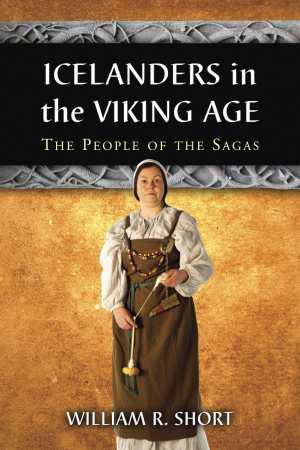Now available from your favorite bookseller.
|
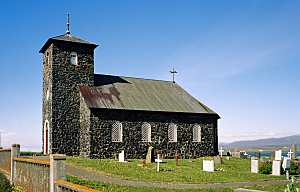
Þingeyrar: Iceland's first monastery was founded here at Þingeyrar and
was a medieval center for learning. Some of the sagas were created in
written form here for the first time. |
Introduction
- an introduction to the Sagas of Icelanders
- problems with understanding the people of the sagas
- scope and limits of the text
- Icelandic personal and place names
- sources
|
|
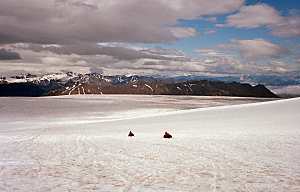
Vatnjökull: Iceland's landscape has been shaped by the forces of fire
and ice, in the form of volcanoes and glaciers. These forces come
together here at the Vatnjökull glacier, which lies on top of active
volcanoes. |
Chapter 1: Land
- geography
- climate
- native animal and plant life
- natural resources of value to the settlers
|
|
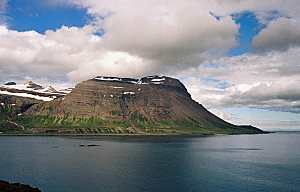
Kaldbakr: Landnámabók tells us that the settler Önundr tré-fótr (wooden
leg) took land here at Kaldbakr. Önundr was uneasy about giving up his fertile
fields in Norway for this cold-backed mountain. |
Chapter 2: Settlement
- settlers
- landholdings
- additional sources and interpretations
|
|
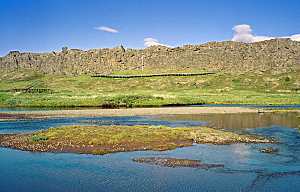
Þingvellir: Key events in many of the sagas take place at Þingvellir,
the site of Iceland's national parliamentary assembly. The annual
session was a time for serious legal business, but it was also a time for
socializing with friends and family from across the land. |
Chapter 3: Government and Law
- early law and regional assemblies
- the creation of Alþing and a national law code
- the government of saga-age Iceland
- the function of Alþing
- legal procedures
- settling disputes
|
|
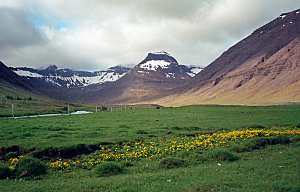
Haukadalr: The differences between free men and slaves are starkly
illustrated in an episode from Gísla saga that took place in Haukadalr.
Gísli escaped his pursuers by taking advantage of the witlessness of his
slave, Þórðr inn huglausi (the coward). |
Chapter 4: Social Structure and Gender
- social structure
- free vs. un-free
- classes in society
- gender roles
- in society
- in marriage and divorce
- in running the farm
- in government
|
|
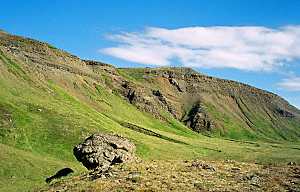
Kjartanssteinn: Laxdæla saga
says that the dispute between Kjartan and
Bolli came to a head at Kjartanssteinn (Kjartan's stone). Here,
Bolli reluctantly ambushed and killed his beloved foster-brother. |
Chapter 5: Feuds, Honor, and the Culture of Combat
- violence and feuds
-
honor and shame
- duels
- vengeance
- feuds
-
Viking-age weapons
-
Viking raids
-
fighting men in the Viking age
|
|
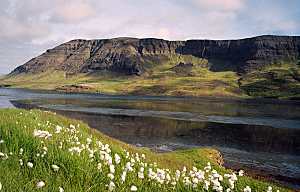
Bægifótshöfði: The ghost of Þórólfr bægifótr (twist-foot) terrified the
local farmers until his son Arnkell reburied the corpse here at
Bægifótshöfði, away from any farm. Eyrbyggja saga says that Arnkell also
built a wall to keep the ghost from returning. |
Chapter 6: Milestones in Life
- birth and infancy
- childhood
- maturity
- marriage
- adult life
- old age
- death
|
|
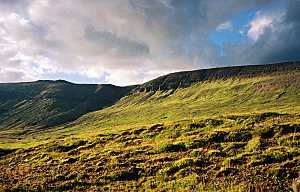
Sælingsdalr: Bolli's farm had summer pastures here at Sælingsdalr,
according to Laxdæla saga. While working here with his wife Guðrún, he
was attacked and killed to avenge the death of Kjartan. |
Chapter 7: Farm, Food Production, and Home Life
- farm
- food
- preservation
- preparation
- nutrition
- famine
- house and home
- longhouses
- turfhouses in Iceland
- other structures
- health, grooming, and medicine
|
|
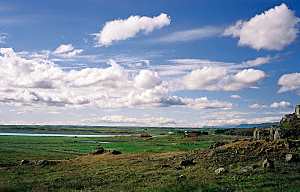
Hvítárvellir: Egils saga and other sources tell us that Hvítárvellir was
an international market and trading center. Merchants beached their
ships on the sandy beach and sold their wares on the open plain. |
Chapter 8: Manufacture and Trade
- crafts
- clothing and fabric
- iron production and blacksmithing
- carpentry
- jewelry and precious metals
- other materials
- trade
- domestic
- foreign
- exchange rates
|
|
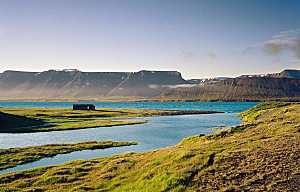
Haukadalsós: Þorbjörn súrr (sour-milk) and his family arrived in Iceland
and sailed their ship into the Haukadalsós estuary here, according to Gísla saga. As the tide
ebbed, the ship was gently deposited on the sandy bottom, where the
cargo could be unloaded with dry feet. |
Chapter 9: Transportation and Navigation
- ships
- war ships
- cargo ships
- ship building
- capabilities of Viking ships
- navigation
- boats
- land travel
- sledges and carts
- skis and skates
- horses
- roads, ferries, bridges
- hospitality for travelers
- reckoning the time and date
- the Icelandic calendar
- astronomical observations
|
|
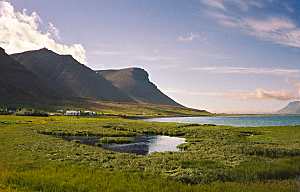
Seftjörn: Gísla saga says that people played knattleikr, the Viking ball
game, near the pond Seftjörn. Little is known about the game, but it was
clearly an enjoyable and often deadly pastime in the Viking age. |
Chapter 10: Art and Leisure
- literature
- language
- runic writing
- poetry
- sagas and other prose
- art
- music and dance
- games and sports
- board games
- ball games
- wrestling and combat sports
- children's toys
|
|
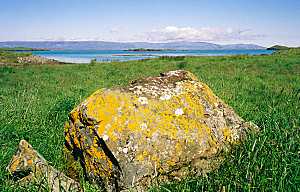
Þórssteinn: Humans were sacrificed on the stone Þórssteinn (Thor's
stone), according to Eyrbyggja saga. The stone was located at the
assembly site immediately adjacent to the sacred mountain Helgafell. |
Chapter 11: Religion, Myth, and Cult
- mythology
- practices and cult
- the supernatural
- magic
- dreams
- the acceptance of Christianity in Iceland
|
|
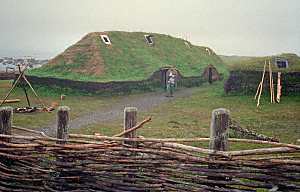
Leifsbúðir: Incontrovertible evidence of a Viking settlement in
Newfoundland has been found. The site may be Leifsbúðir where, according
to Grænlendinga saga, Leifr Eiríksson built houses similar to these
reconstructed turfhouses. |
Chapter 12: Exploration and Settlement to the West
|
|
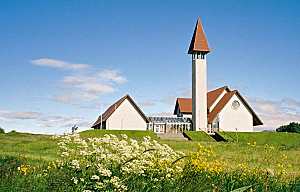
Reykholt: Snorri Sturluson, the saga author, poet, diplomat, and
chieftain lived at Reykholt. Today, Snorri's farm is the site of a
church, museum, and medieval research center. |
Chapter 13: Iceland's Heritage
- internal power struggles
- the loss of independence
- marginalization and poverty
- rediscovery of Iceland's literary heritage
- saving the saga manuscripts
- the sagas in modern society
|
|
|
Appendix
Notes
Glossary
Selected References
Acknowledgements
Index
|
